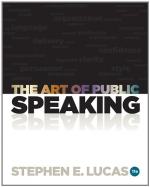Often last of all will come that which in a sense is first of all—the title, the name by which the speech is known. Sometimes it will be the simple theme of the address, as “The New Americanism,” by Henry Watterson; or it may be a bit of symbolism typifying the spirit of the address, as “Acres of Diamonds,” by Russell H. Conwell; or it may be a fine phrase taken from the body of the address, as “Pass Prosperity Around,” by Albert J. Beveridge. All in all, from whatever motive it be chosen, let the title be fresh, short, suited to the subject, and likely to excite interest.
QUESTIONS AND EXERCISES
1. Define (a) introduction; (b) climax; (c) peroration.
2. If a thirty-minute speech would require three hours for specific preparation, would you expect to be able to do equal justice to a speech one-third as long in one-third the time for preparation? Give reasons.
3. Relate briefly any personal experience you may have had in conserving time for reading and thought.
4. In the manner of a reporter or investigator, go out and get first-hand information on some subject of interest to the public. Arrange the results of your research in the form of an outline, or brief.
5. From a private or a public library gather enough authoritative material on one of the following questions to build an outline for a twenty-minute address. Take one definite side of the question, (a) “The Housing of the Poor;” (b) “The Commission Form of Government for Cities as a Remedy for Political Graft;” (c) “The Test of Woman’s Suffrage in the West;” (d) “Present Trends of Public Taste in Reading;” (e) “Municipal Art;” (f) “Is the Theatre Becoming more Elevated in Tone?” (g) “The Effects of the Magazine on Literature;” (h) “Does Modern Life Destroy Ideals?” (i) “Is Competition ’the Life of Trade?’” (j) “Baseball is too Absorbing to be a Wholesome National Game;” (k) “Summer Baseball and Amateur Standing;” (l) “Does College Training Unfit a Woman for Domestic Life?” (m) “Does Woman’s Competition with Man in Business Dull the Spirit of Chivalry?” (n) “Are Elective Studies Suited to High School Courses?” (o) “Does the Modern College Prepare Men for Preeminent Leadership?” (p) “The Y.M.C.A. in Its Relation to the Labor Problem;” (q) “Public Speaking as Training in Citizenship.”
6. Construct the outline, examining it carefully for interest, convincing character, proportion, and climax of arrangement.
NOTE:—This exercise should be repeated until the student shows facility in synthetic arrangement.
7. Deliver the address, if possible before an audience.
8. Make a three-hundred word report on the results, as best you are able to estimate them.
9. Tell something of the benefits of using a periodical (or cumulative) index.




